On-line retailer guests predict fast and seamless purchasing experiences.
Pages have to load quick. Checkout processes should be environment friendly. And merchandise are anticipated to reach in a matter of days.
Delivering on these expectations could be difficult. However a robust technical basis and optimized ecommerce structure make it attainable to fulfill consumers and develop what you are promoting.
What Is Ecommerce Structure?
Ecommerce structure refers back to the approach manufacturers construction numerous technical parts of their ecommerce programs. And the way these parts work together with one another.
These parts could embrace product pages, cell apps, cost processing, databases, and different frontend and backend features.
Kinds of Ecommerce Structure
Ecommerce structure parts could be organized in numerous methods. There are less complicated setups—like monolithic or two-tier—extra suited to manufacturers which have restricted ecommerce wants. There’s much less code to take care of, so it’s cheaper and simpler to work with.
However manufacturers with extra demanding ecommerce wants could go for microservice, three-tier, and different advanced ecommerce construction setups. These provide extra performance. However they may also be pricey and tougher to take care of.
Let’s cowl among the most vital ecommerce architectures.
Monolithic Ecommerce Structure
Monolithic ecommerce structure refers back to the setup through which the person interface, enterprise logic, and knowledge entry layers are mixed in a single codebase.
This strategy has a number of benefits:
- Simplicity: Simpler to develop, deploy, and handle on account of its single-tier construction
- Reliability: Since all parts are tightly built-in, points could be extra predictable and managed uniformly
However there are additionally a number of disadvantages:
- Scalability points: It may be troublesome to scale a particular a part of the appliance with out scaling the complete system
- Rigidity: Making modifications could be dangerous and time-consuming, affecting the complete system
Smaller manufacturers could notably desire a monolithic structure. A small retailer, as an example, could select this easy-to-maintain structure if it has no plans to scale its restricted product and buyer base.
Microservice Ecommerce Structure
Microservice structure is a setup through which numerous ecommerce programs and enterprise features (i.e., stock administration) function independently. They speak to one another by application programming interfaces (APIs).
Microservice construction gives a couple of benefits:
- Scalability: Providers could be scaled independently based mostly on demand for particular options
- Flexibility: Simpler to replace and keep since modifications to at least one service don’t immediately affect others
However there are additionally some challenges:
- Complexity: Requires subtle coordination and administration of varied companies
- Useful resource-intensive: Every microservice may want separate databases and different sources, which may enhance overhead
Giant digital retailers, as an example, could use microservice structure to handle various product classes. This setup permits them to scale explicit classes, like cell gadgets, with out impacting different dwelling home equipment or private computer systems classes.
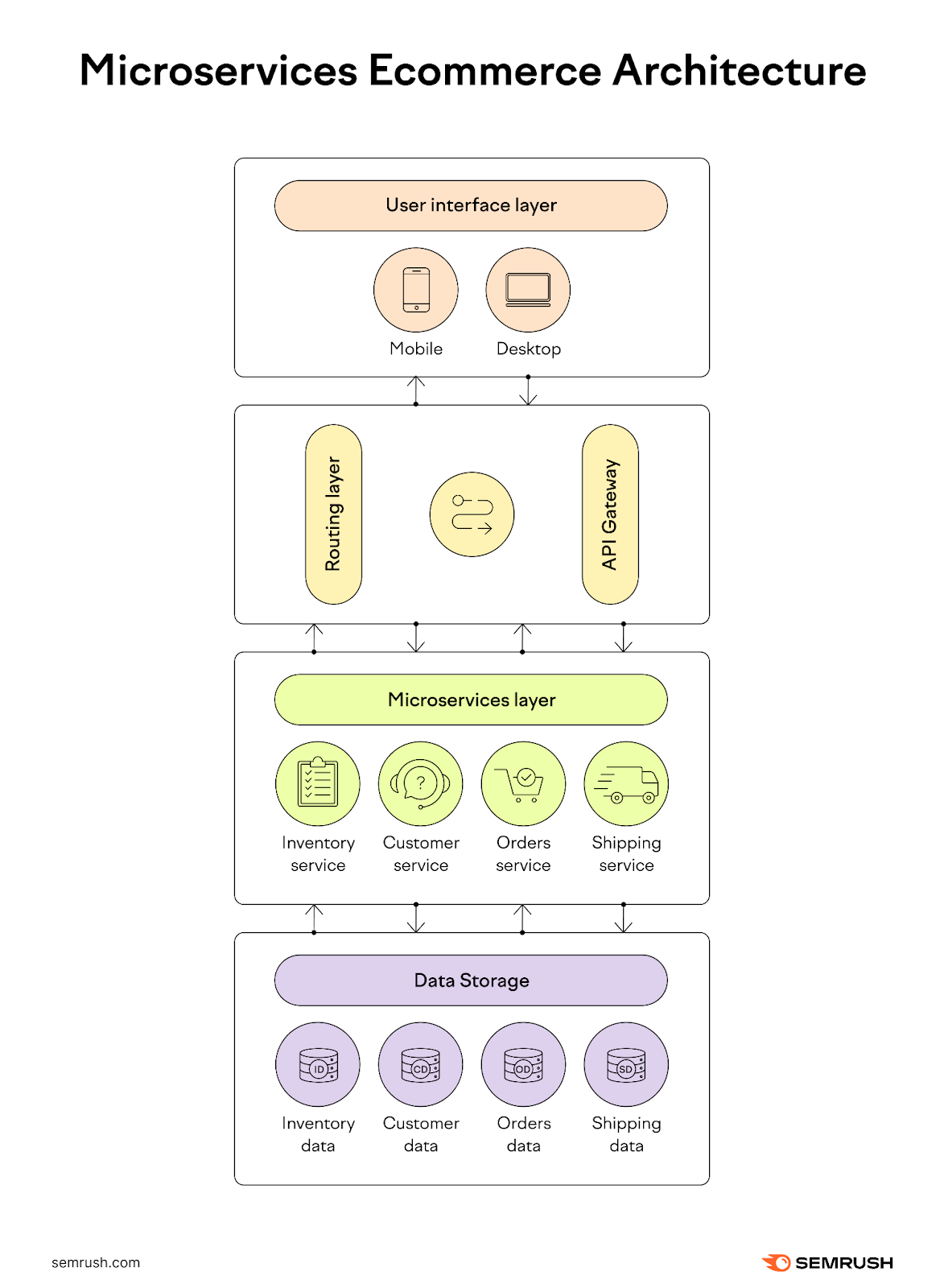
Two-Tier Ecommerce Structure
Two-tier structure comprises two fundamental layers:
- The interface layer: The person interface that’s normally within the type of a web site or cell app
- The information layer: Servers the place all the information storage, processing, and retrieval is carried out
Consumers talk immediately with the server to retrieve knowledge (like product costs and pictures) and carry out enterprise operations (like including objects to a cart).
This strategy has a number of advantages:
- Efficiency: Can improve efficiency by distributing duties between server and consumer
- Simply manageable: Simplifies server-side administration by separating enterprise logic from consumer interface
However there are additionally some drawbacks:
- Restricted scalability: The client-server mannequin can turn out to be a bottleneck if the person base grows considerably
- Safety dangers: Extra publicity factors, as knowledge has to journey between two distinct layers
Each smaller and bigger manufacturers could use two-tier ecommerce structure. A boutique luxurious store, for instance, could use this structure to offer a wealthy client-side expertise by an interactive web site. And its strong backend server handles all enterprise transactions and stock administration.
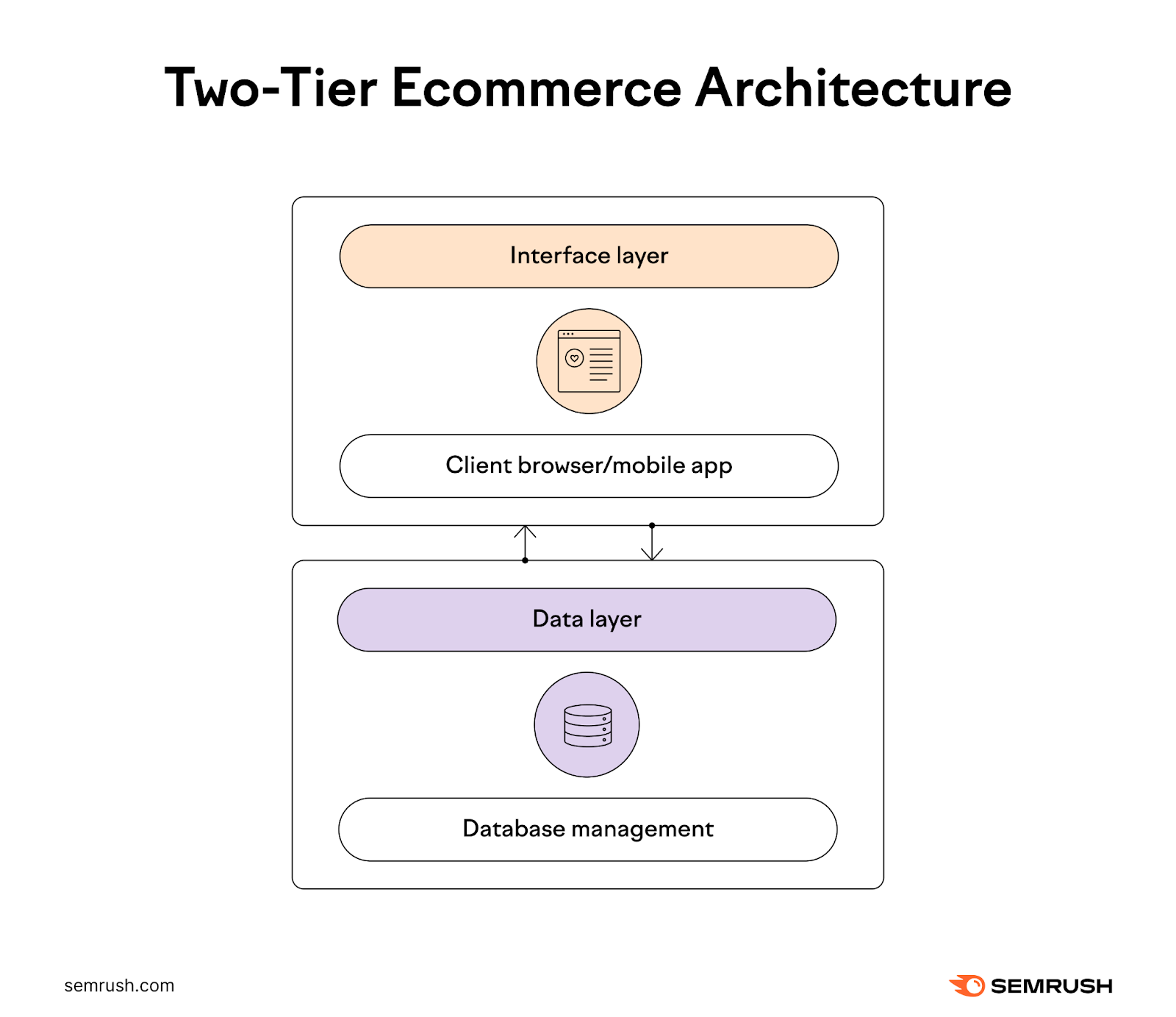
Three-Tier Ecommerce Structure
In three-tier structure, an software layer is launched between the interface and the information layers. This center tier gathers and processes knowledge, making modifications to the information layer.
The applying layer can carry out extra superior features. For instance, it may well monitor and save person cost, product, and transport preferences. In order that subsequent time, customers don’t must enter cost or transport strategies and are served customized product suggestions.
There are numerous advantages to the three-tier strategy:
- Scalability: Every layer could be scaled independently, enhancing total software efficiency
- Flexibility: Simpler to switch or exchange particular person tiers with out affecting others
And there are some drawbacks as effectively:
- Complexity: Extra advanced to handle and keep as a result of elevated variety of parts
- Price: Doubtlessly larger operational prices on account of extra subtle infrastructure wants
A web based bookstore, as an example, can undertake a three-tier structure to handle person interactions, enterprise processing, and knowledge storage individually. This permits them to supply ebook suggestions on the consumer aspect, course of transactions within the center tier, and handle a listing database.
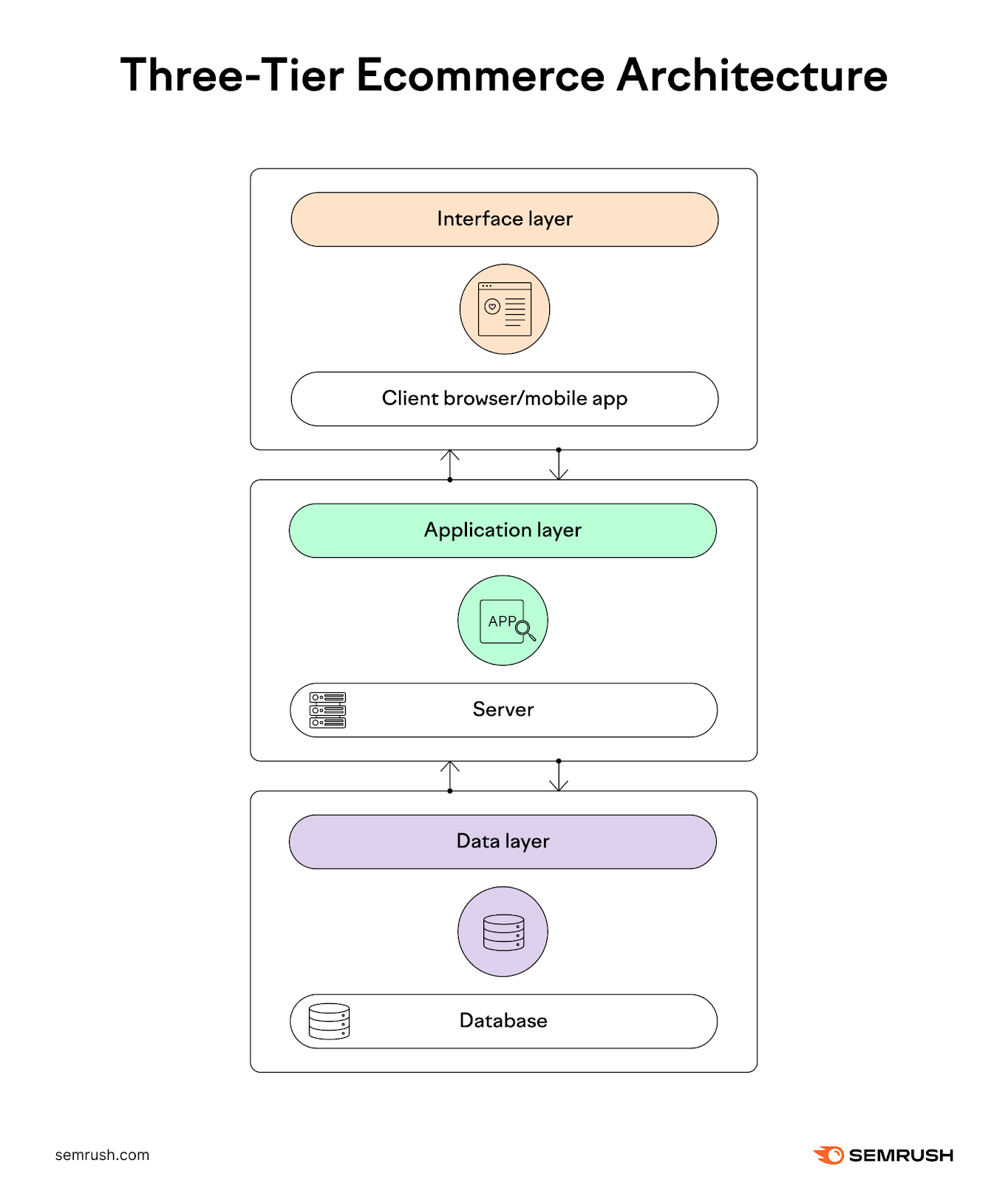
Headless Ecommerce Structure
Headless ecommerce structure decouples the frontend layer (web site or a cell app) from the backend. Builders can then use any know-how to construct the frontend expertise. And the communication with an ordinary backend is achieved by a headless API layer.
This strategy gives a number of advantages:
- Flexibility: Permits the usage of numerous frontends for various gadgets or platforms with out modifying the backend
- Enhanced person expertise: Permits for sooner deployments and updates to the person interface with out backend interference
However there are additionally some disadvantages:
- Complexity: Requires superior improvement expertise to handle separate programs successfully
- Integration challenges: Integrating a number of frontends with a typical backend could be advanced
Headless strategy may match effectively for some firms. As an example, a vogue retailer could go for a headless structure to offer a seamless purchasing expertise throughout cell apps, desktop web sites, and even wearable gadgets. And all of those experiences are managed by a single backend.
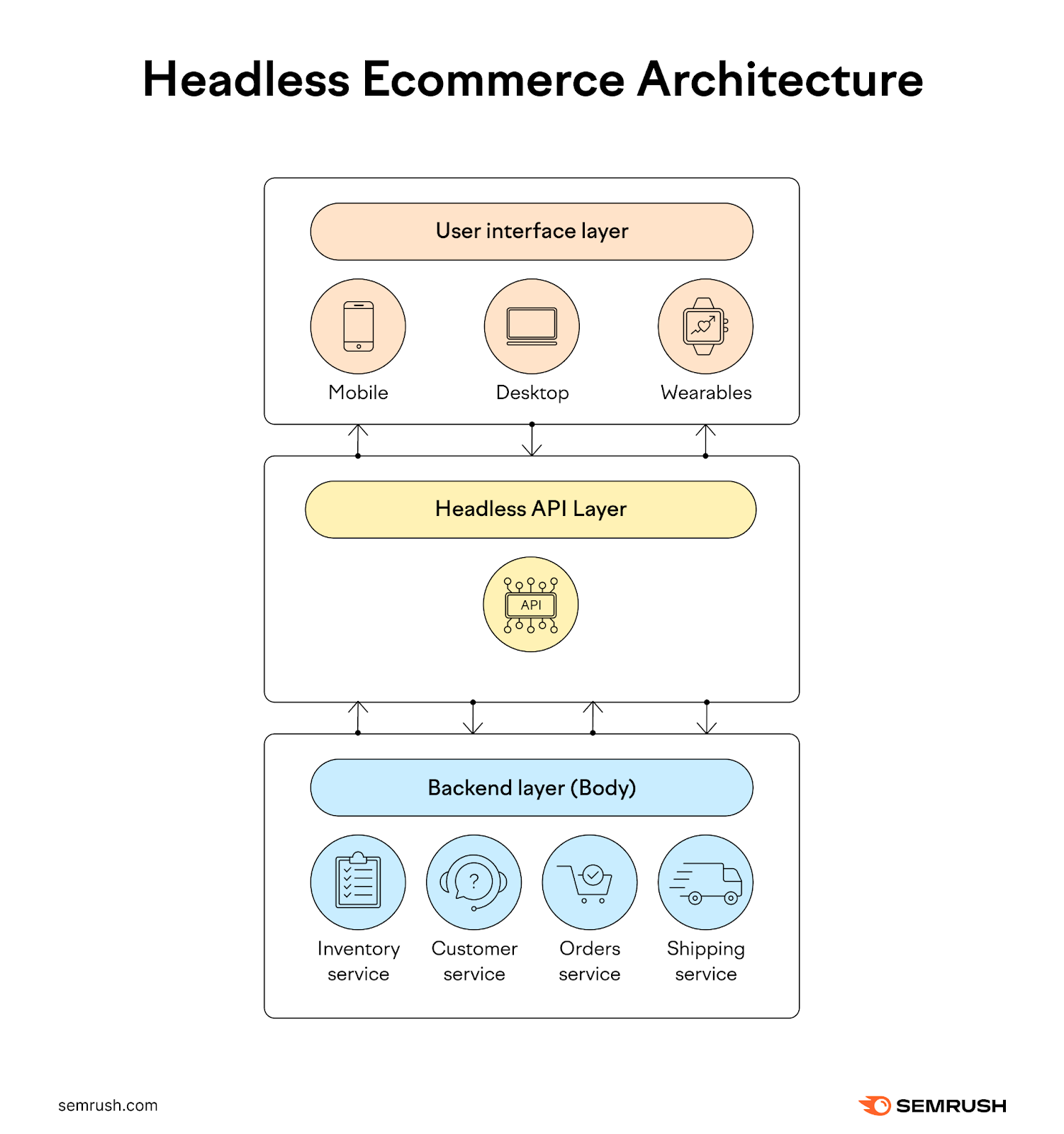
SaaS Ecommerce Structure
Software program as a Service (SaaS) ecommerce structure is a web-based, out-of-the-box resolution the place ecommerce functionalities are managed by a third-party supplier. The supplier—Shopify, for instance— is liable for sustaining, internet hosting, and upgrading current settings.
There are a number of advantages of this mannequin:
- Price-effective: Reduces the necessity for preliminary capital funding in {hardware} and software program
- Upkeep-free: The SaaS supplier manages updates, safety, and infrastructure
There are some drawbacks, too:
- Much less management: Companies have restricted management over the platform and rely closely on the supplier
- Customization limits: Could provide restricted customization choices in comparison with different architectures
This structure is very enticing to startups. They’ll use a SaaS ecommerce platform to launch their on-line retailer rapidly with out the necessity for vital upfront funding in IT infrastructure. This permits them to concentrate on product improvement and advertising as an alternative.
Advantages of a Clear Ecommerce Web site Structure
An optimized ecommerce structure is vital as a result of it advantages companies in numerous methods.
For instance, it delivers SEO advantages, together with:
- Improved crawlability: A well-structured web site construction permits search engine bots to simply crawl and index the complete web site. New product pages then seem in search outcomes sooner.
- Enhanced web site authority: Efficient structure helps distribute page authority all through the positioning. Backlinks to the homepage or fundamental class pages go authority to subpages, serving to them rank for extra key phrases.
A transparent ecommerce web site structure additionally offers person expertise advantages. Similar to:
- Ease of navigation: Customers discover what they’re on the lookout for with minimal effort and revel in a satisfying shopping expertise
- Improved accessibility: A transparent construction is simpler to navigate utilizing assistive applied sciences and thus extra pleasant to customers with disabilities
There are additionally numerous advertising and gross sales advantages a transparent ecommerce construction delivers:
- Elevated conversion charges: A transparent path from landing pages to checkout reduces person frustration and abandonment charges, immediately enhancing conversion rates and gross sales
- Higher buyer retention: A web site that’s straightforward to navigate encourages prospects to return, boosting retention charges
All of those and different advantages make it vital to create and keep an optimized ecommerce structure.
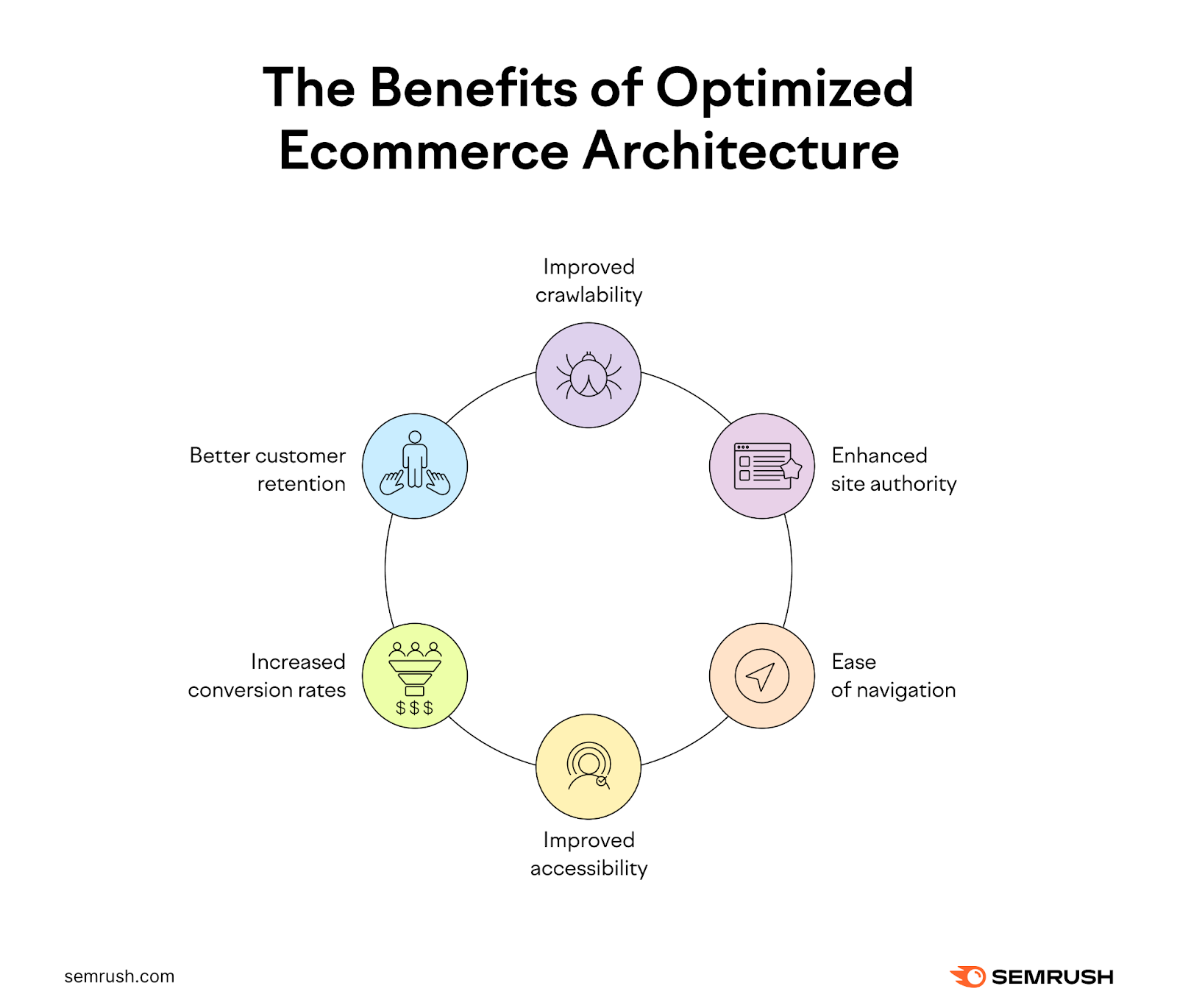
Ecommerce Structure Elements
Ecommerce structure can get pretty advanced. Dozens, if not tons of, of various ecommerce parts work together with one another to ship a seamless purchasing expertise.
Let’s go over among the most vital parts used to create the most effective structure for an ecommerce web site.
Frontend Elements
The frontend of an ecommerce web site is what the purchasers work together with immediately, akin to a web site or an app. It’s presupposed to be user-friendly and visually interesting. This interface layer consists of parts like:
- Menu: A navigation instrument that shows the varied classes and companies out there on the web site
- Class pages: Webpages that mixture merchandise underneath particular classes
- Product pages: Pages that present particulars about every product, together with descriptions, costs, and pictures
- About us web page: A web page that provides insights into the corporate’s historical past, mission, and values
- Search bar: A characteristic that permits customers to sort in key phrases to search out merchandise or data on the positioning rapidly
- Footer: A piece on the backside of every web page that usually consists of hyperlinks to vital data akin to contact particulars, FAQs, and insurance policies
- Buyer critiques: Suggestions from patrons about their product experiences
- Promotions and banners: Visible components highlighting particular gives, reductions, or new merchandise to have interaction customers
Middleware Elements
This middleware layer serves as a bridge between the frontend and the backend. It could even be known as the appliance layer, dealing with all the information circulation and processing between the entrance and backends. It consists of parts like:
- Purchasing cart: A digital cart that permits customers to gather and alter their meant purchases earlier than checkout
- Cost gateway: A system that processes and secures cost data and transactions
- Person authentication: A safety measure that verifies the identities of customers logging into the platform
- Stock administration: Software program that tracks product availability and updates inventory ranges in actual time
- APIs: Instruments that allow integration and communication between totally different software program functions
- Session administration: Expertise that maintains a person’s interactions throughout webpages throughout their go to
- Analytics: Techniques used to evaluate person behaviors and preferences to optimize the purchasing expertise
- Safety protocols: Requirements and applied sciences designed to guard the positioning and person knowledge from cyber threats
Backend Elements
The backend layer consists of the database and server-side parts that retailer and handle knowledge. This server layer helps the frontend by easy knowledge administration and repair performance. Key parts embrace:
- Database administration system: This software program shops and organizes all important knowledge. Similar to person profiles, product data, and transactions.
- Order administration system: Software program that manages the processing and success of buyer orders
- Content material administration system: Instruments that enable non-technical directors to replace web site content material
- Knowledge backup programs: Applied sciences that save copies of the positioning’s knowledge to forestall loss in case of a failure
- Electronic mail companies: Capabilities that automate sending emails associated to advertising, confirmations, and assist
- Person administration programs: Controls that handle entry ranges and permissions for various customers of the platform
- Server administration system: Infrastructure that ensures the web site operates easily, managing server sources successfully
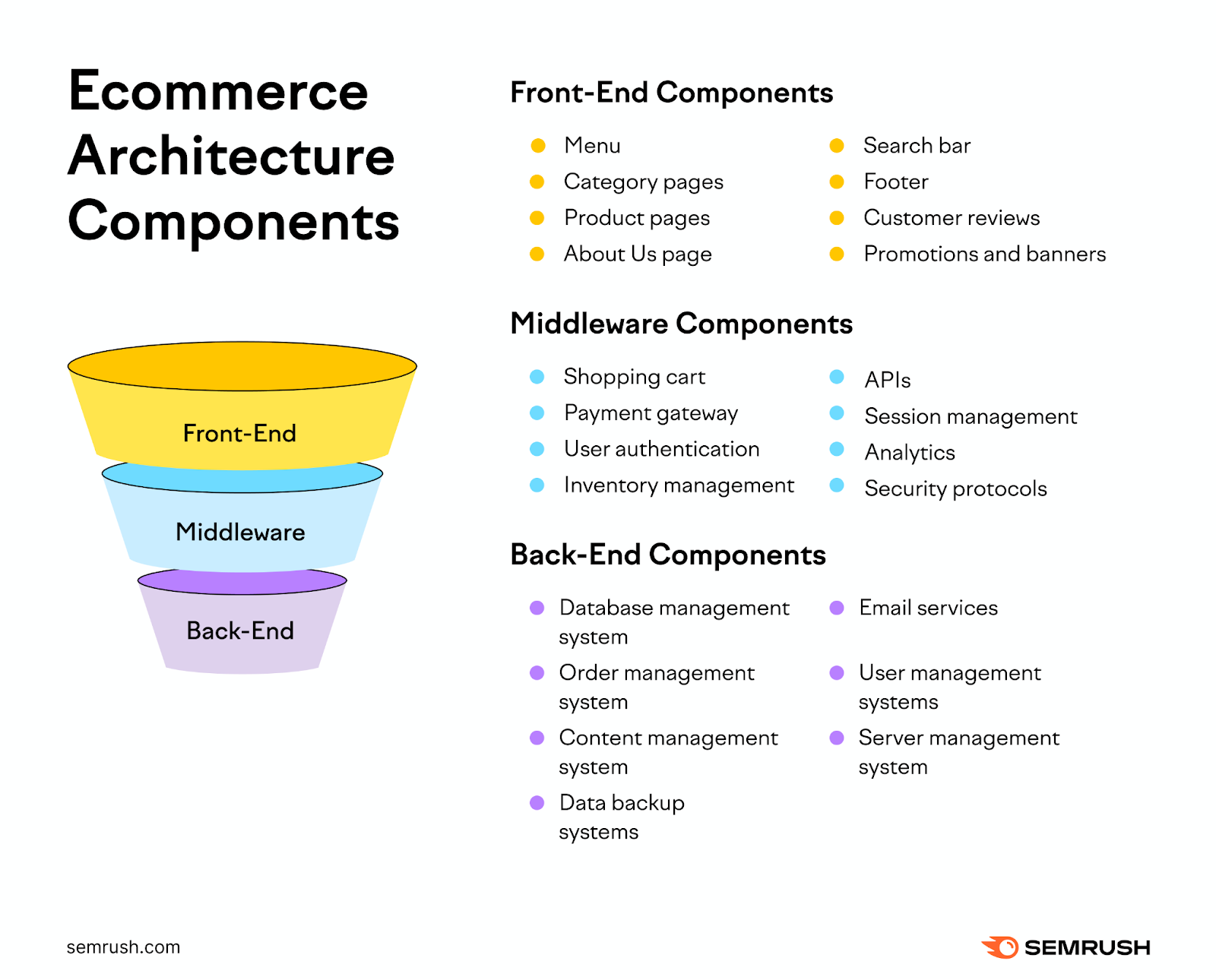
Ecommerce Structure Finest Practices
Varied ecommerce manufacturers could have totally different wants from their web site construction.
As an example, the U.S. ecommerce large Amazon could prioritize the velocity and scalability of their ecommerce structure. Whereas one-person ecommerce manufacturers could worth the convenience of stock administration and transport.
However there are specific ecommerce structure greatest practices that just about any firm would profit from implementing.
Select the Structure Finest Match for Your Enterprise Wants
Your ecommerce structure ought to be capable of observe your evolving enterprise wants.
Listed below are a number of components to contemplate to reach on the proper ecommerce construction:
- Site visitors development: Think about the scale of your on-line retailer now and the way massive it would get. If you’re going after a big viewers and count on excessive visitors quantity, then your ecommerce setup ought to be capable of accommodate such development. Scalable microservices structure might be one choice to contemplate.
- Product selection: You might have just a few merchandise now however plan so as to add many extra sooner or later. If that’s the case, your web site construction ought to make it straightforward to scale your providing by including new merchandise, pages, and options. On this occasion, going after features-friendly, three-tier structure might be a viable choice.
- Finances constraints: Your price range dictates the kind of ecommerce structure you possibly can construct and keep. You could like sure architectures. But when they’re out of your price range, it’s higher to compromise with much less subtle however dependable options akin to monolithic structure.
- Technical sources: When you have an in-house IT crew, you could really feel assured deploying a extra customizable and sophisticated ecommerce construction (like a microservices construction). In any other case, deploying a user-friendly however much less versatile platform with the assistance of third-party builders may be a much less dangerous choice.
Map Out Your Ecommerce Construction
When you’re making ready to construct or revamp your ecommerce construction, take a while to map out your required structure first. Don’t leap immediately into constructing it.
Map your structure both electronically or by hand. Embody all of the pages you propose to construct, like product pages or the contact web page. And visualize how all of them hyperlink to one another. Add notes on which options and parts totally different pages can have.
This train helps you perceive what the everyday shopper journey in your web site will appear like. And whether or not it’s too sophisticated.
Mapping out your ecommerce structure upfront additionally helps you keep away from pricey redesigns. Since you already know the positioning construction. And which applied sciences, integrations, and frameworks you’ll deploy.
Develop an Intuitive Web site Navigation
An ecommerce web site navigation must be intuitive and logical. Class, subcategory, and product pages must be labeled with acquainted phrases, not business jargon.
As an example, right here’s how Etsy labels its product classes. All of those phrases are straightforward to grasp and also you immediately know what to anticipate.
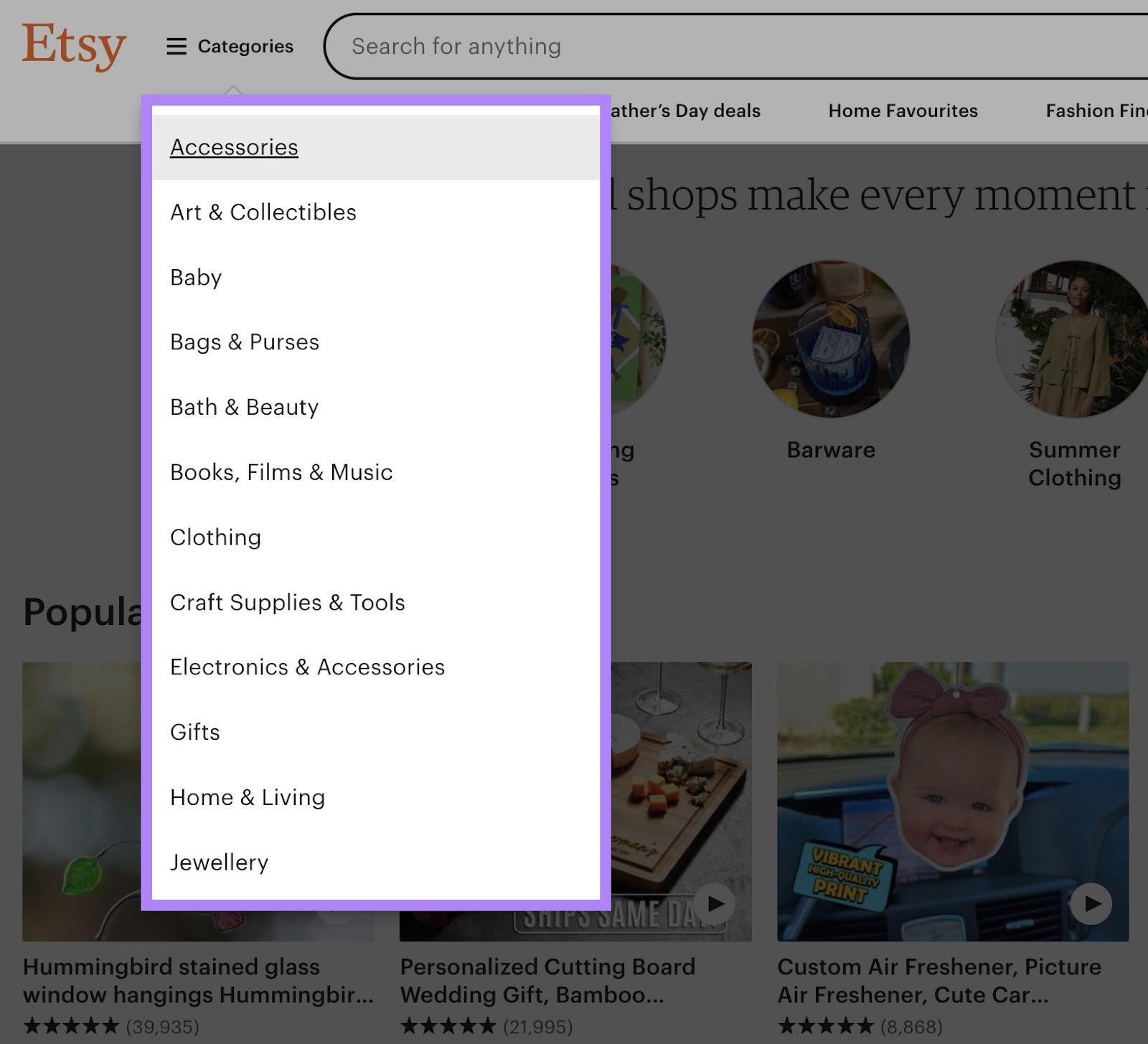
And while you open a subcategory, Etsy already shows all the knowledge you could have to resolve if you wish to buy a product. You will get from a homepage to a checkout web page intuitively in simply three clicks.

There are a number of different methods to create an intuitive web site navigation:
- Maintain important hyperlinks like “Residence” or “Merchandise” accessible from any web page
- Use constant design throughout various kinds of pages for a cohesive expertise
- A search bar must be positioned on the prime of every web page
- Use breadcrumb navigation to tell customers of their location on the web site
- Simplify the navigation for cell consumers utilizing options like hamburger menus
Right here’s what a hamburger menu appears like in follow:
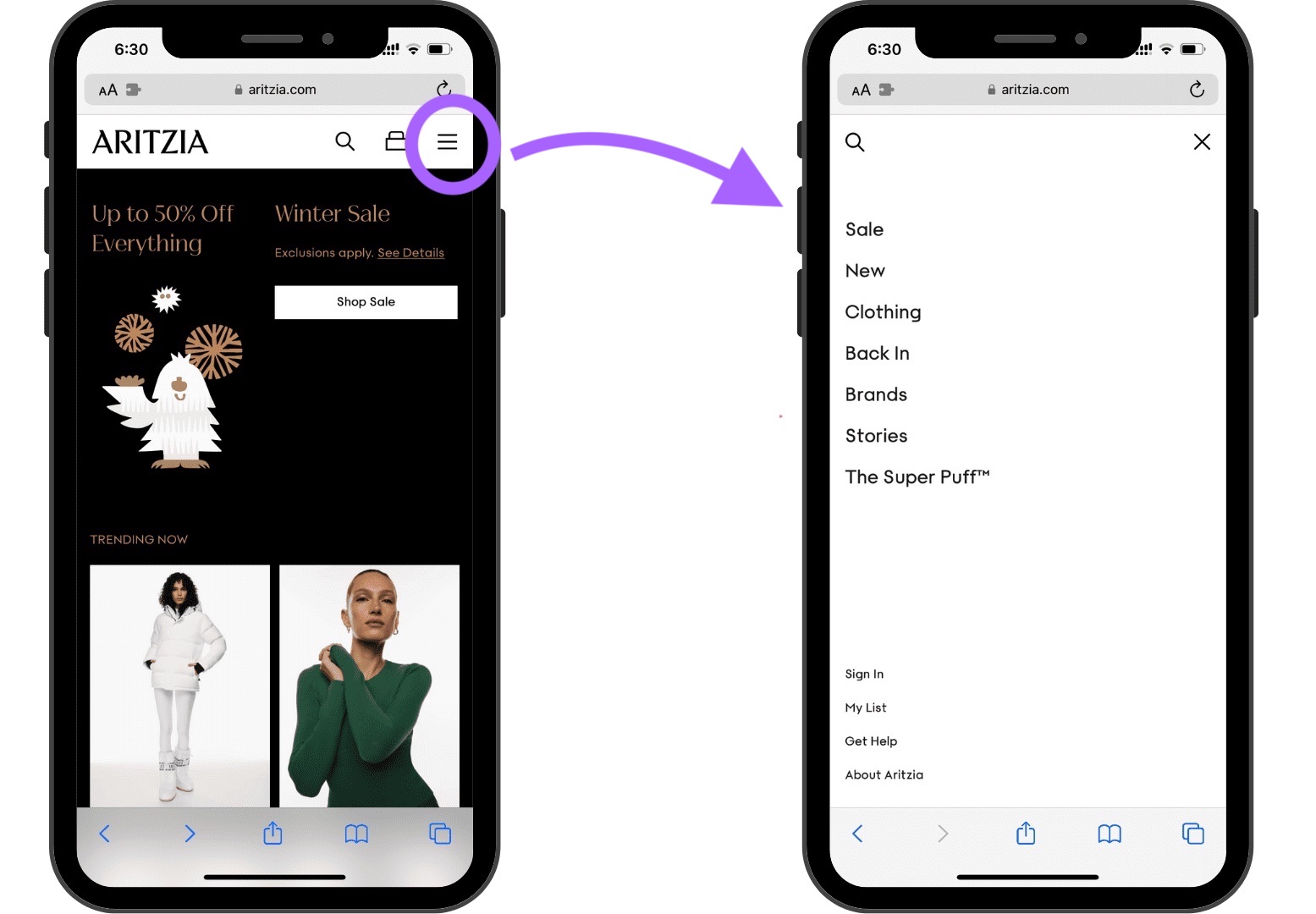
Allow customers to search out what they need rapidly, and they’re extra prone to make a purchase order.
Make Your Ecommerce Construction Cellular-Pleasant
Your ecommerce structure’s parts must be optimized for mobile users. Listed below are a number of ways to realize that objective:
- Use a responsive design that adjusts the format based mostly on the system’s display dimension
- Maintain the menu objects restricted to important classes to keep away from overcrowding
- Use optimized images with smaller file sizes that look good and cargo rapidly
- Use bigger button sizes, easy-to-select hyperlinks, and ample spacing to forestall unintentional clicks
- Decrease the usage of heavy scripts and animations to optimize web site velocity
- Streamline the checkout for cell customers by requiring fewer steps to make a purchase order
The Chinese language ecommerce behemoth AliExpress is a superb ecommerce structure instance. Its desktop and cell variations are totally different.
Its desktop model, as an example, has 24 distinct product classes.
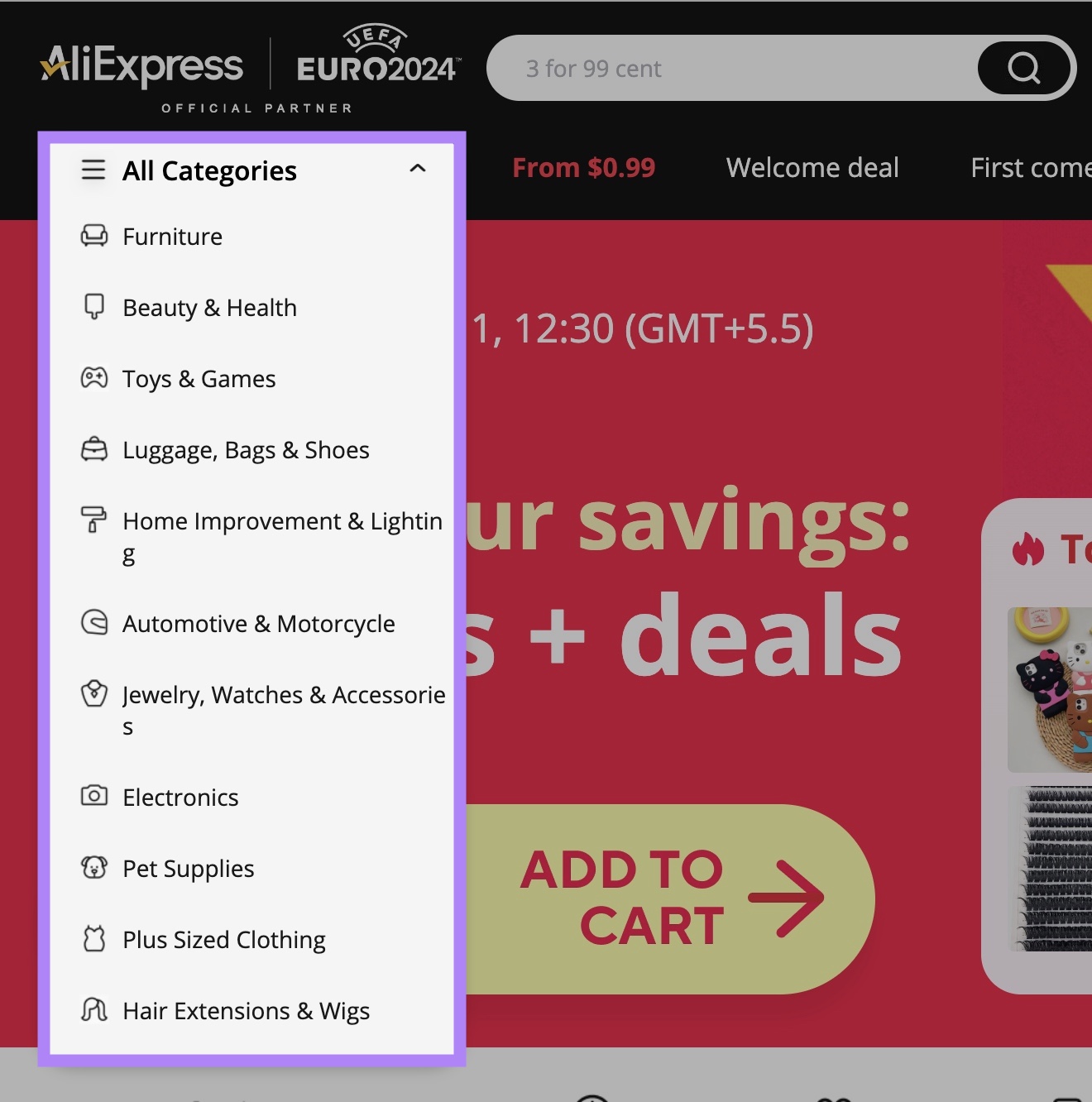
However on its cell model, the corporate solely lists the 9 hottest classes on its homepage.
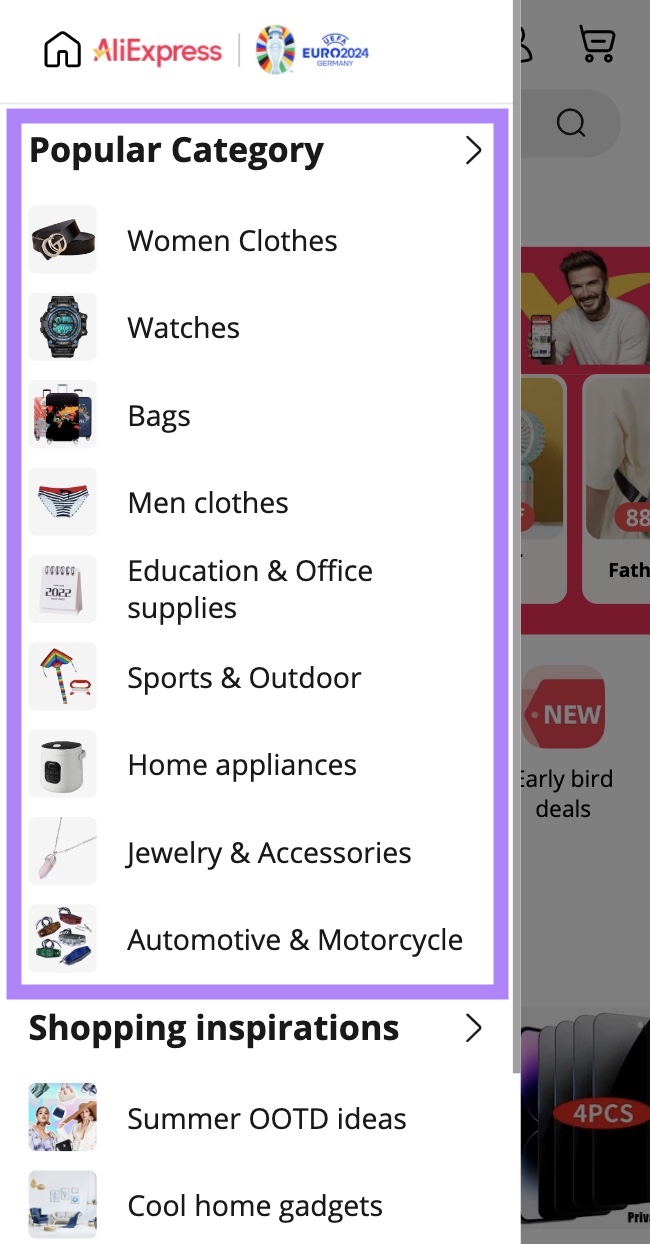
Much less litter on cell variations helps guests discover their approach to a desired product.
Making your ecommerce structure design mobile-friendly can go a good distance in serving to guests get pleasure from your web site. And, finally, convincing them to buy a number of merchandise.
Optimize Your Ecommerce Structure for Search engine optimization
There are a number of methods to optimize your class and product pages to assist drive natural visitors.
For starters, your homepage ought to hyperlink to class pages. Then, class pages ought to hyperlink to their respective particular person product pages.
Like this:
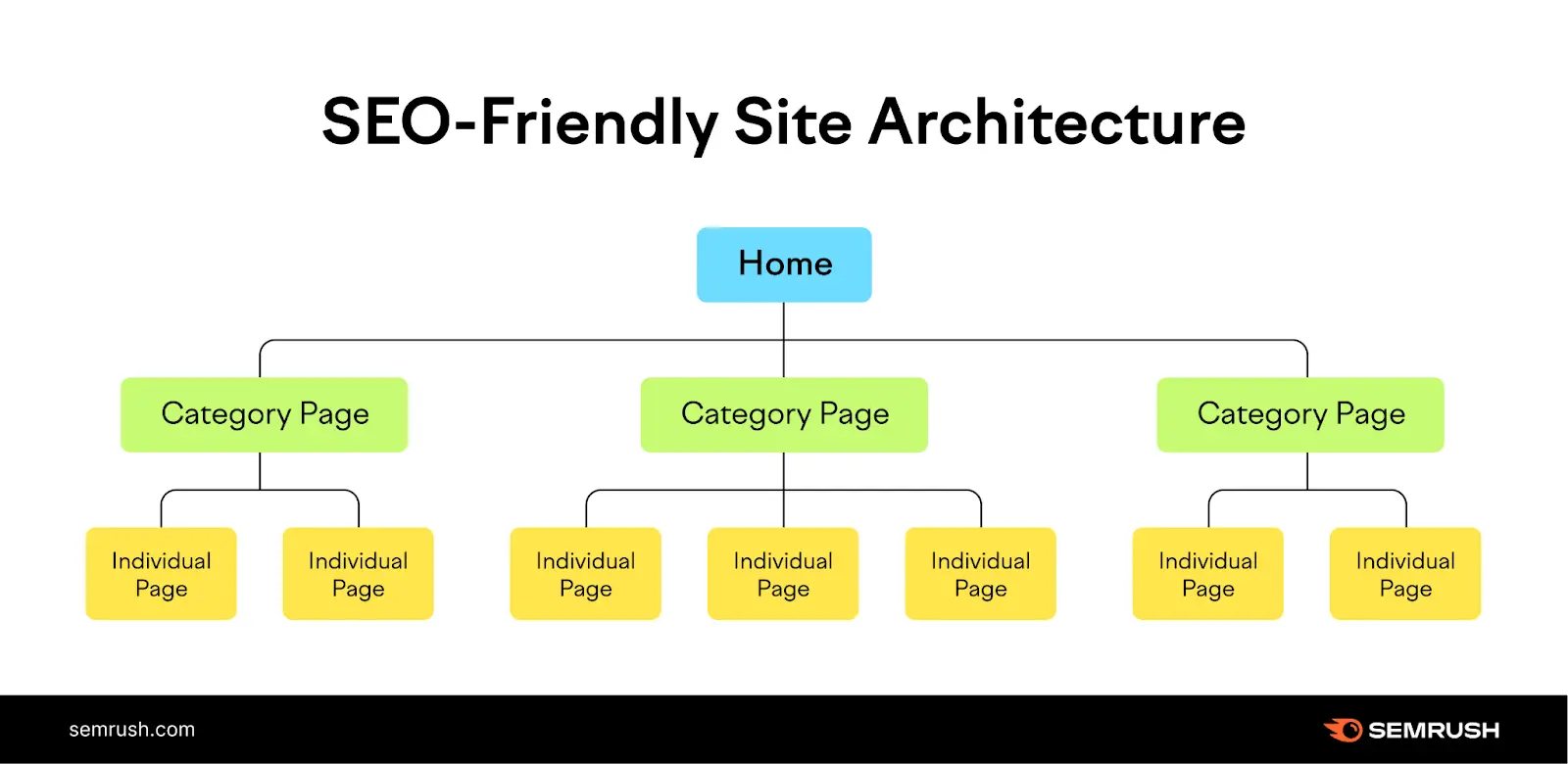
This helps go web page authority from the homepage to different pages. And in return, these pages could find yourself rating larger for his or her goal key phrases.
You also needs to hyperlink to your product pages out of your weblog posts. This and different internal linking greatest practices helps your web site turn out to be Search engine optimization-optimized and simpler to navigate.
You also needs to determine numerous product-related key phrases to call your class and product pages.
Use Semrush’s Keyword Magic Tool to search out related key phrases that may assist optimize your web page titles and content material for higher search engine visibility.
Right here’s how:
Head to the instrument, sort in your class identify, and click on “Search.”
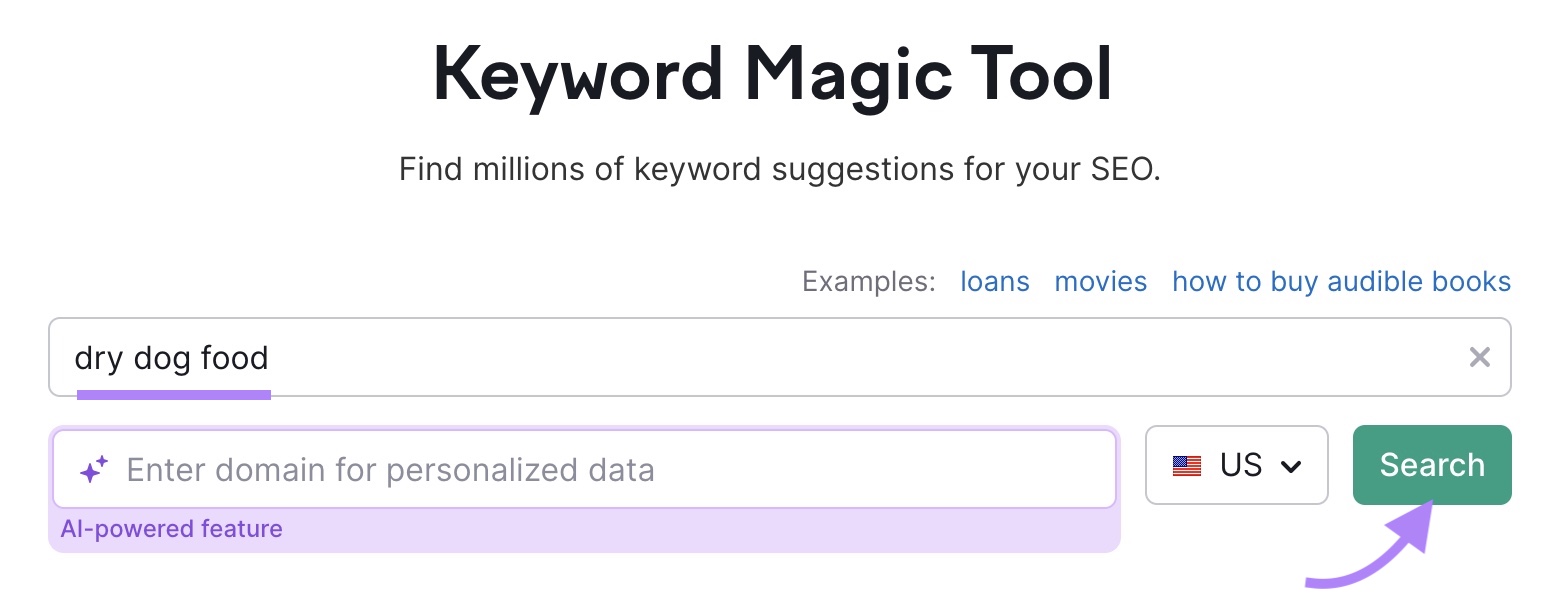
Subsequent, you’ll get a listing of varied key phrases that comprise your class identify.
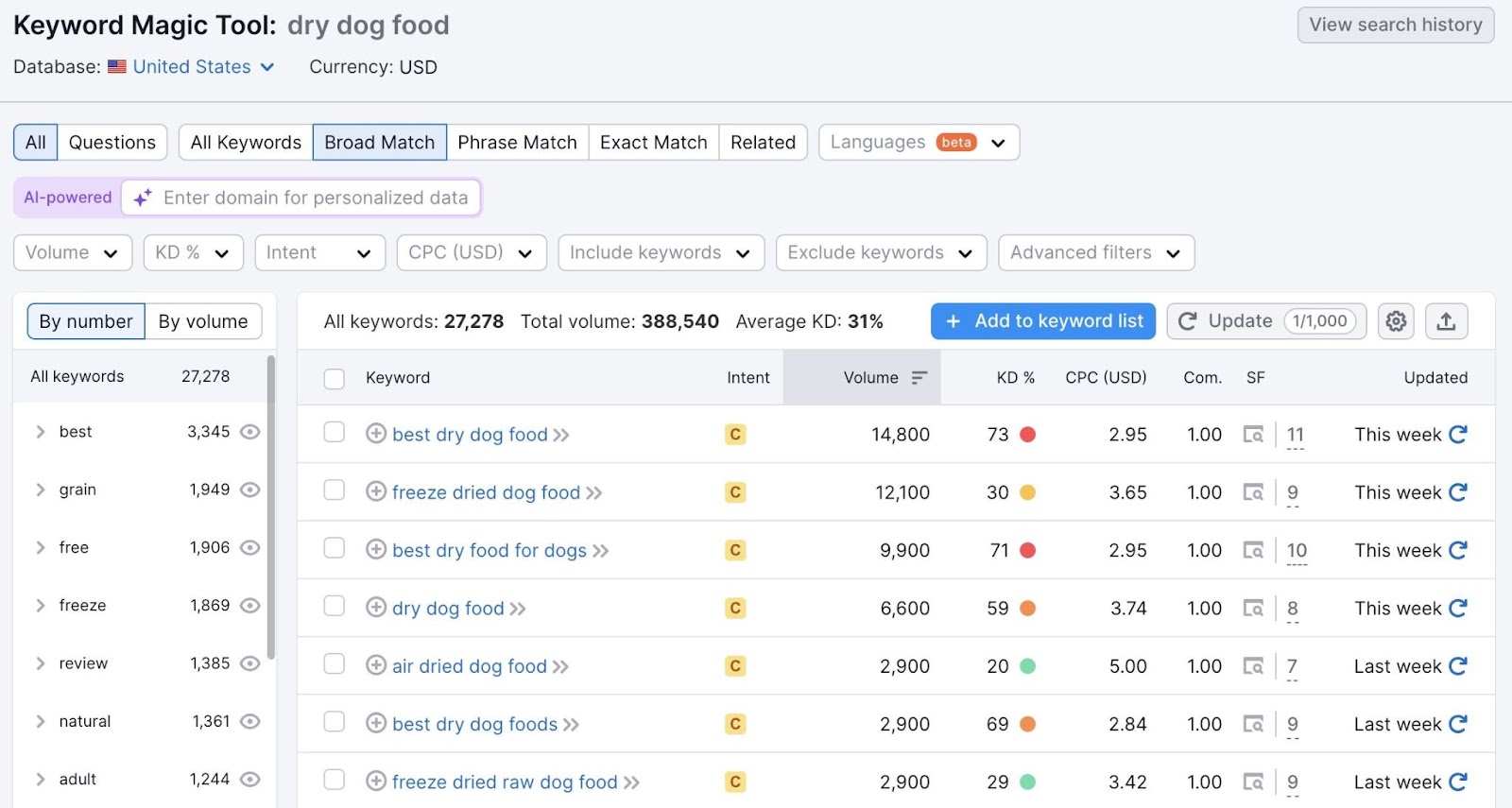
You’ll see numerous knowledge factors for every key phrase, together with month-to-month search volume, search intent, keyword difficulty (KD%), and extra.
The instrument lets you type the checklist by any of those and different knowledge factors.
This offers you with particular key phrases that your viewers varieties in search engines like google and yahoo. Use these identical phrases when naming your product pages to assist your web site present up in search outcomes.
You also needs to optimize every web page. For instance, embrace goal key phrases in fundamental titles, headings, content material, and URLs.
Constantly Audit & Enhance Your Ecommerce Web site
Ecommerce web sites constantly add and take away merchandise and choices. New pages are always being launched, and the positioning construction is ever-changing.
It’s vital to observe your web site for any points. As an example, checking that new pages are interlinked with different pages. In order that Google crawlers can crawl and index each web page on the positioning. Or that pages load quick with no safety vulnerabilities.
Use Semrush’s Site Audit instrument to observe your ecommerce web site for any technical issues.
Right here’s how:
Open the instrument, enter your area, and click on “Begin Audit.”

Then, configure your basic settings by specifying whether or not you need subdomains to be audited as effectively. Set the restrict of checked pages and the crawl supply.
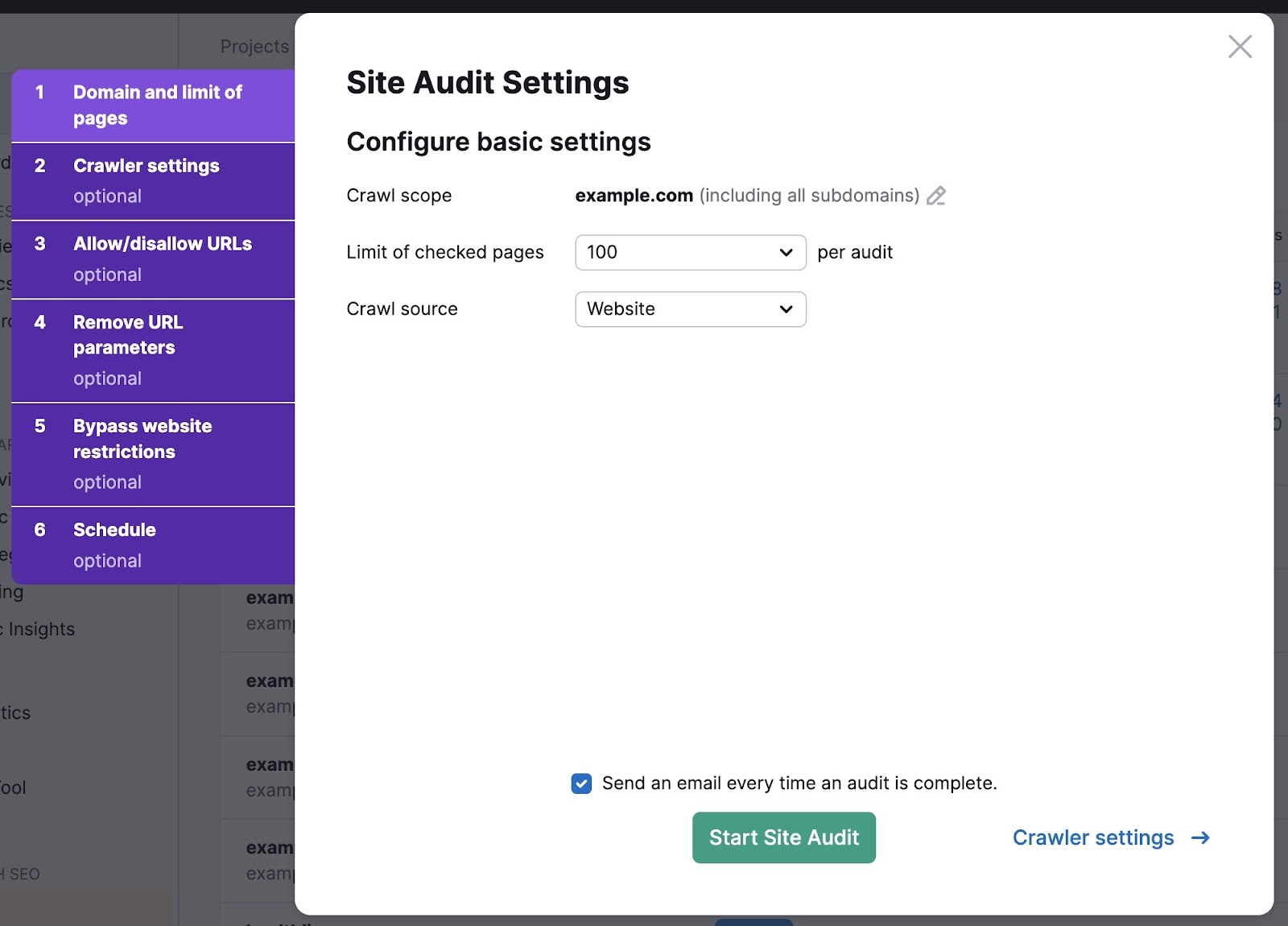
In case your ecommerce web site is huge, you could wish to schedule weekly and even each day audits. Set this within the “Schedule” tab.
Examine the field “Ship an e-mail each time an audit is full” to obtain an e-mail following an audit. Subsequent, click on “Begin Website Audit.”
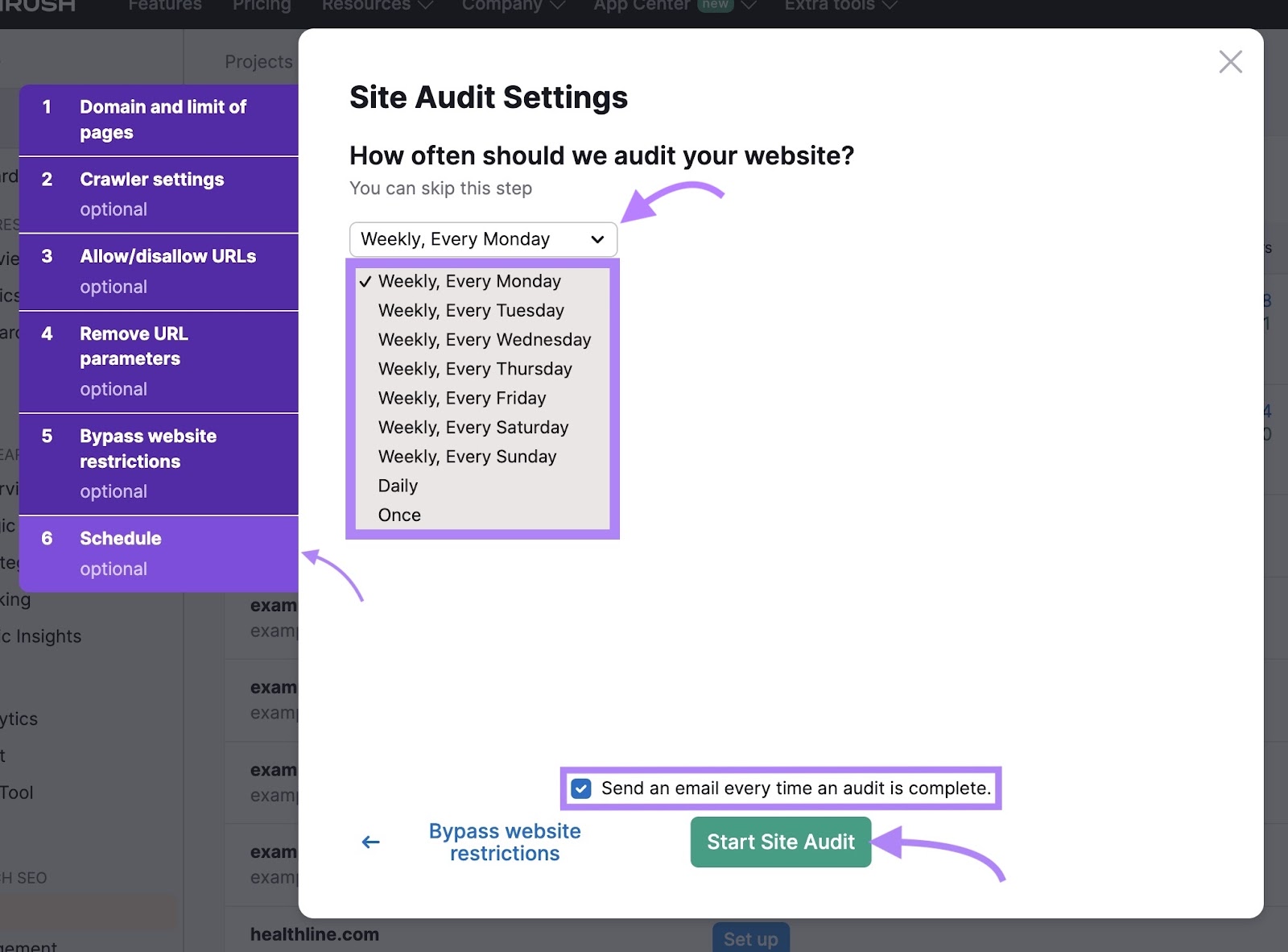
As soon as the audit is full, navigate to the “Overview” report. It is a high-level view of your web site’s total well being.
Discover your “Site Health” rating within the higher left nook. The rating is calculated based mostly on the size of errors and points discovered in your ecommerce web site. The upper the rating, the higher.
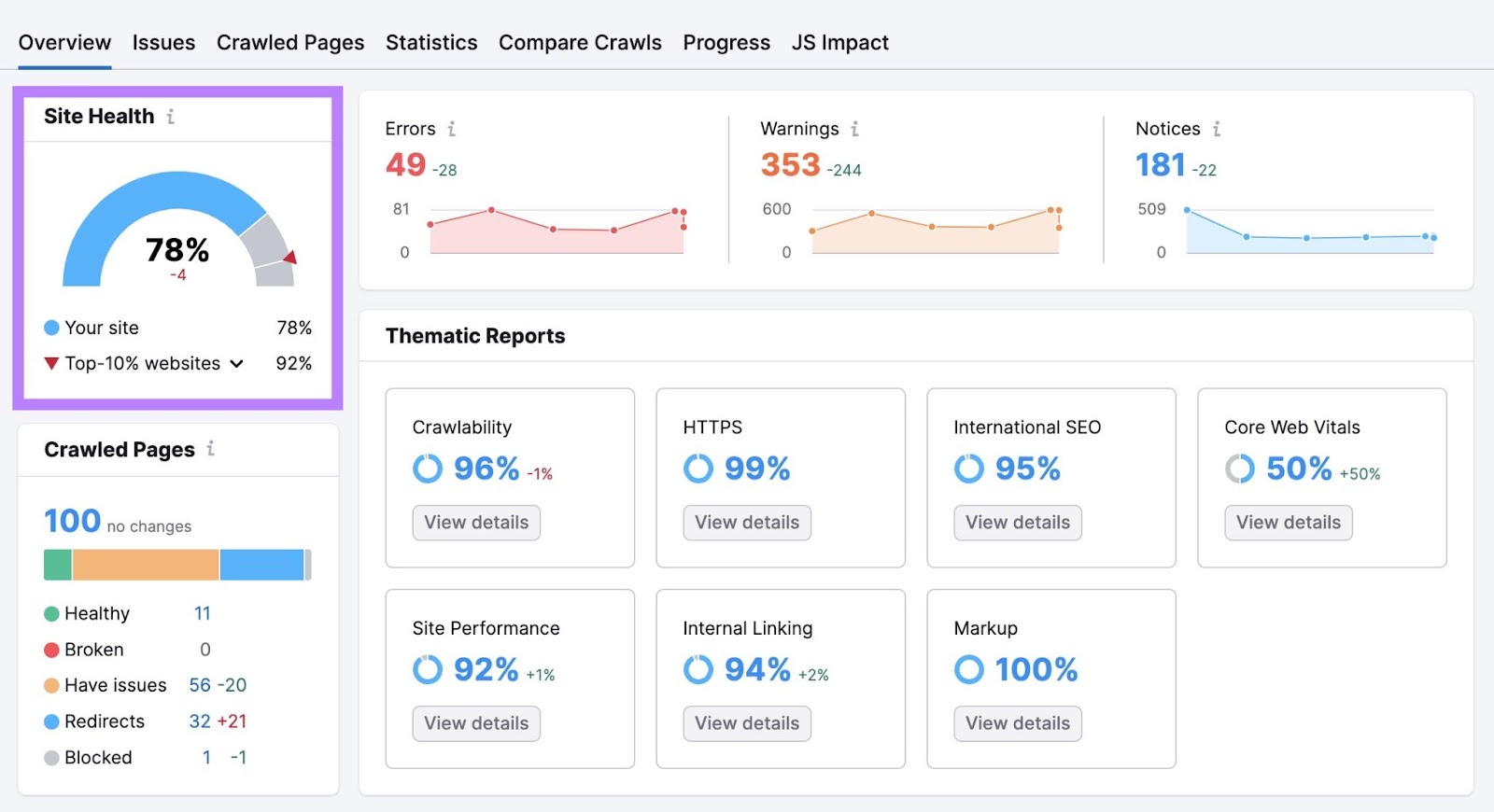
Head to the “Points” tab to search out all the issues your web site faces.
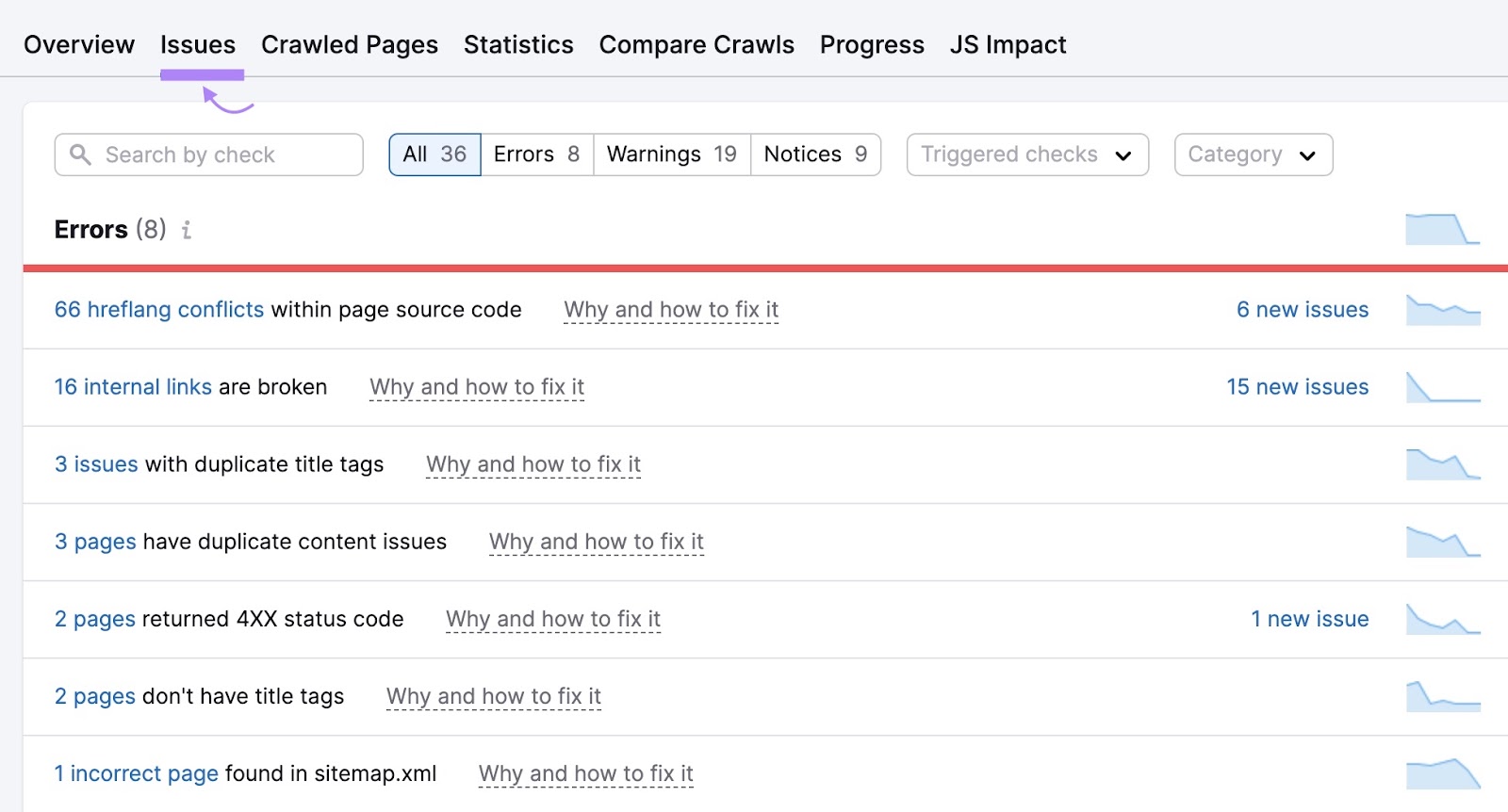
Begin fixing “Errors” first, that are the problems of the very best severity. Then, transfer on to “Warnings.” “Notices” don’t have an effect on the well being rating.
Click on “Why and methods to repair it” to get further data on methods to handle given points.
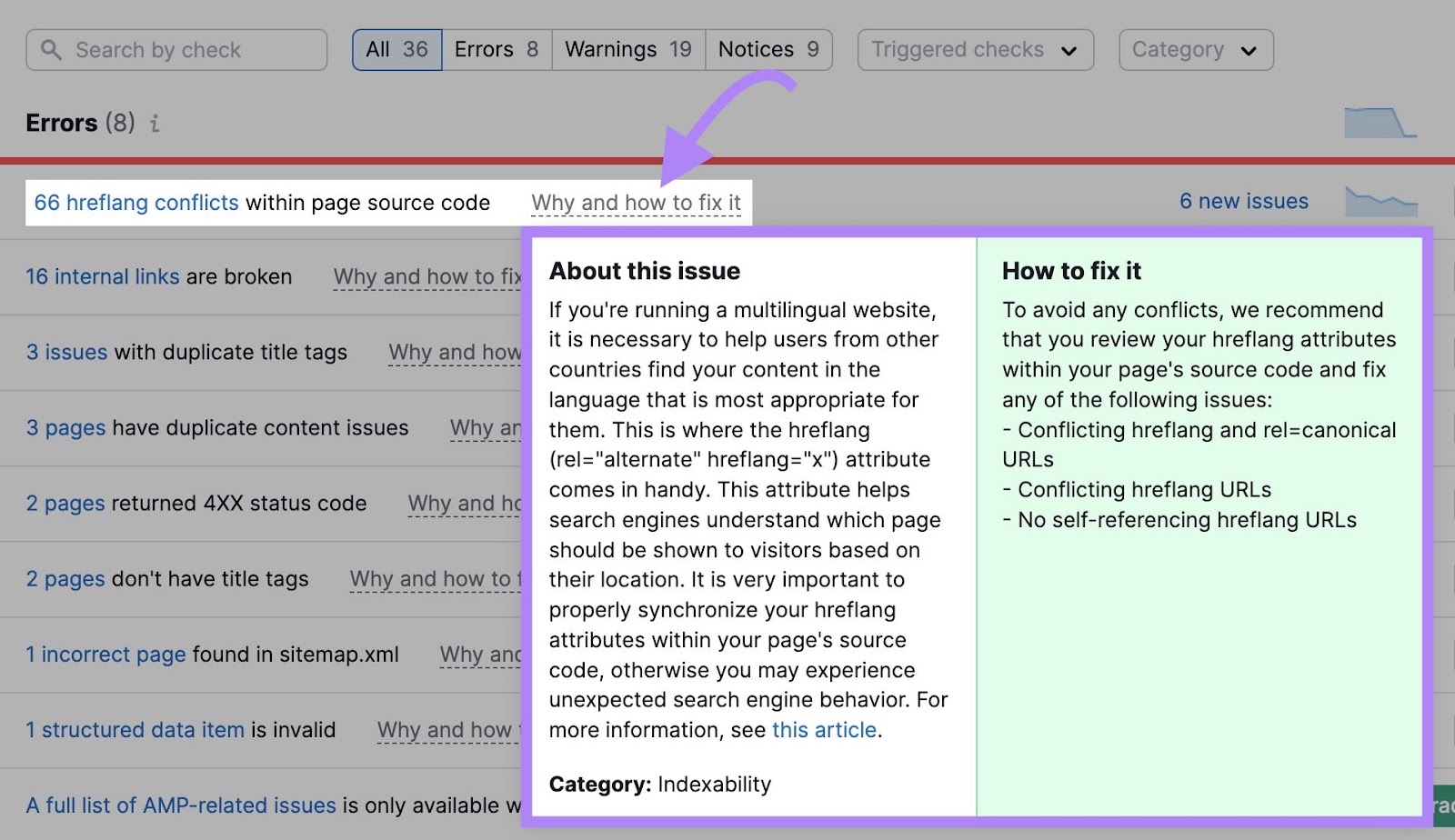
Fortify Your Ecommerce Structure with Semrush
Ecommerce structure constantly evolves as new applied sciences and options are rolled out.
Being aware of the most effective practices on this area is vital.
In any other case, manufacturers threat being left behind by rivals with extra user-friendly web site buildings.
Use Semrush’s suite of instruments to empower your ecommerce enterprise. The Keyword Magic Tool can assist you determine related key phrases, whereas Site Audit will aid you monitor technical points in your web site.
Sign up for free at present to get began.




